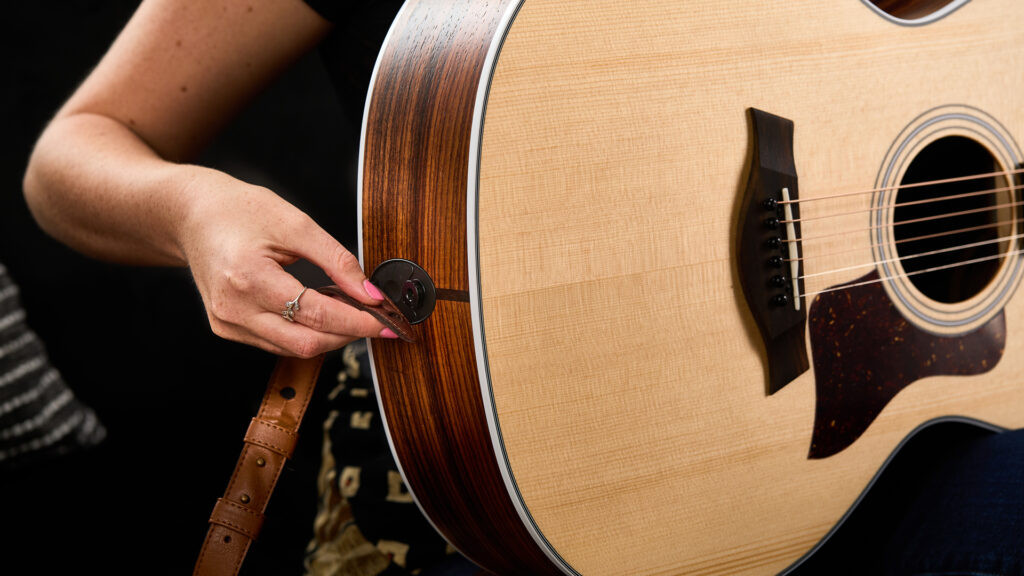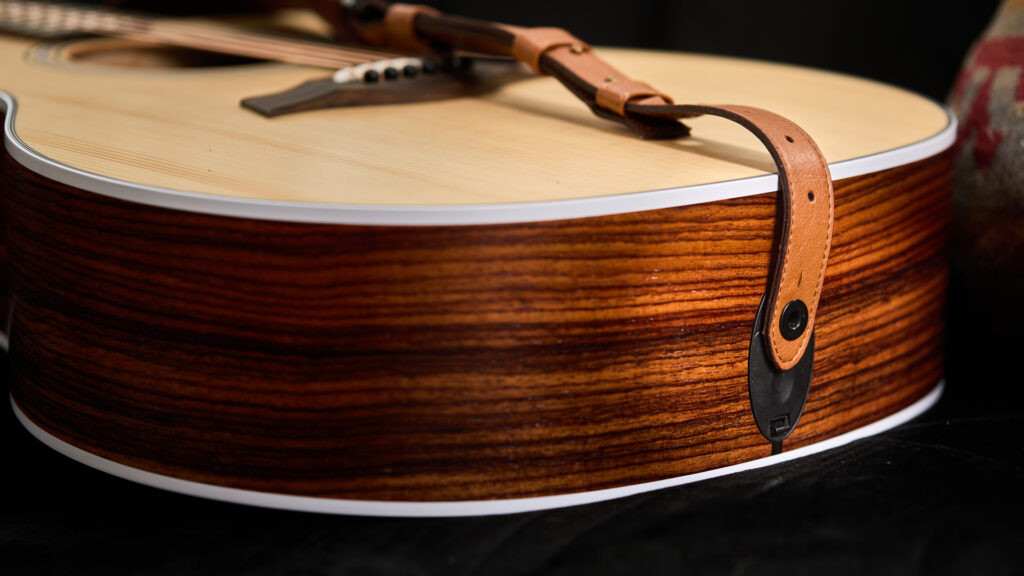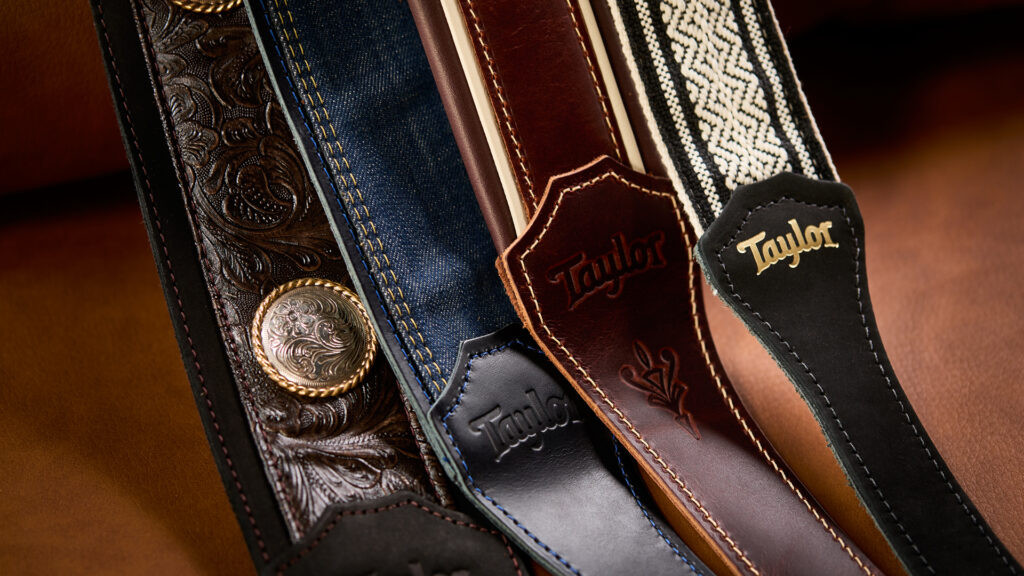Putting a guitar strap on correctly is essential for any guitarist, ensuring comfortable and ergonomic playing, whether you’re standing up at a local gig or practicing at home. At guitarplayers.net, we’ll guide you through the process of attaching your guitar strap properly, so you can focus on what matters most: making music. You’ll learn the different methods for various guitar types, strap adjustment techniques, and how to choose the best strap for your needs, enhancing your playing experience.
1. Understanding Guitar Strap Basics
Before diving into the how-to, it’s important to understand the different types of guitar strap attachments. The most common variations involve guitars with two strap pins (or buttons) and those with only one. Knowing which setup you have is the first step in properly attaching your strap.
1.1 What Are Strap Pins (Buttons)?
Strap pins, also known as strap buttons, are small, rounded metal posts that protrude from the body of the guitar. They serve as anchor points for the guitar strap, securing the instrument to the player. Electric guitars and basses almost always come equipped with two strap pins, and many acoustic guitars do as well.
1.2 Types of Guitar Strap Setups
There are primarily two types of guitar strap setups:
- Two-Pin Setup: This is the most common setup, especially for electric guitars and some acoustic models. One pin is usually located at the bottom end of the guitar, and the other is either on the upper shoulder of the body or behind the neck where it meets the body.
- One-Pin Setup: Many acoustic guitars come with only one strap pin, located at the bottom of the instrument. In this case, the strap is typically attached to the headstock using a lace or strap adapter.
2. How to Attach a Guitar Strap with Two Pins
If your guitar has two strap pins, attaching the strap is relatively straightforward. Here are the steps to follow:
2.1 Orient the Strap Correctly
First, make sure you orient the strap correctly. While some straps are designed to be used in either direction, many have a specific top and bottom.
- If your strap has a sliding plastic buckle, the end with the two overlapping layers of material should be oriented towards the bottom pin.
- If one end of the strap is thinner than the other, the thinner end should be attached to the bottom pin.
- Ends with designs or logos usually attach to the pin near the neck.
 Orienting a guitar strap with a logo to attach to the pin near the neck, ensuring correct strap direction
Orienting a guitar strap with a logo to attach to the pin near the neck, ensuring correct strap direction
2.2 Attach the Strap to the Bottom Pin
Take one end of the guitar strap and locate the hole or slit designed for the strap pin. Insert the strap pin through this hole, ensuring the strap fits snugly against the body of the guitar. You may need to use a bit of force to get it over the pin, especially if the strap is new.
2.3 Attach the Strap to the Top Pin
Take the remaining end of the strap and insert the remaining strap pin through the corresponding hole or slit. Again, ensure the strap fits snugly.
2.4 Test the Installation
After attaching both ends, give the strap a gentle tug on each side to ensure it’s securely in place. This test will help you avoid any accidental drops while playing.
According to research from Fender, in June 2024, testing the strap installation can prevent up to 90% of accidental guitar drops during performances.
Even if your guitar has two strap pins, you might prefer the one-pin method, especially if you want to change the guitar’s balance.
3. How to Attach a Guitar Strap with One Pin
Many acoustic guitars come with only one strap pin at the bottom of the instrument. While you can install a second pin, the standard method is simple and doesn’t require any drilling.
3.1 Secure the Strap to the Bottom Pin
Start by following the first two steps of the two-pin method: orient the strap and attach one end to the bottom pin.
3.2 Attach the Strap to the Headstock
Since there’s no strap button on the upper part of the guitar, you’ll need to secure the other end of the strap to the headstock. Use a lace or a strap adapter for this purpose. Many straps come with a lace specifically for this.
3.3 Using a Lace
Feed the lace through the hole in the strap. Then, thread one end of the lace underneath the strings on the headstock, near the nut. Tie a tight double knot to secure it.
3.4 Using a Strap Adapter
If you’re using a strap adapter, secure one end to the strap and the other around the headstock using the supplied pin.
3.5 Consider the Balance
Attaching the strap to the headstock versus using two strap buttons changes the guitar’s balance. When the strap is fixed to the headstock, the guitar’s weight feels more balanced toward the center. With two strap buttons, the center of gravity shifts slightly toward the lower part of the guitar. Experiment to see which setup feels best for you.
4. Adjusting the Guitar Strap for Comfort
Finding the right strap length is crucial for comfortable playing. Adjusting the strap on the fly is also essential, especially during live performances.
4.1 Ergonomic Factors
Strap length is largely a matter of personal preference and aesthetics, but ergonomics play a significant role. The strap should be adjusted so that you never have to fully bend your wrist to reach notes or chords while standing. Relaxing your fret hand and wrist can prevent strain and injuries.
4.2 Straps with Sliding Plastic Buckles
If your strap has a sliding plastic buckle, adjusting it is simple. To lengthen the strap, slide the buckle toward the lower part of the guitar. To shorten it, slide the buckle toward the neck. This can be done without removing the strap.
4.3 Leather or Suede Straps
Leather or suede straps usually don’t have a plastic buckle. Instead, they consist of two separate pieces. To adjust these straps, you need to detach the smaller piece from the larger one. This must be done with the strap removed from the instrument.
4.4 Adjusting Leather/Suede Straps
The slits in the wide strap piece correspond to different strap lengths. Thread the thin strap piece up through the underside of the strap and pull tight. Then, feed it back through itself by passing through the adjacent slit. Finally, thread it through at least one of the other slits as it makes its way down to the bottom strap button. Experiment with different slits to find the right height.
 Adjusting a leather guitar strap by threading the thin strap piece through the slits on the wide piece to find the correct length
Adjusting a leather guitar strap by threading the thin strap piece through the slits on the wide piece to find the correct length
5. The Importance of Guitar Strap Locks
Once you’ve adjusted your strap to the desired length, consider securing it with strap locks. Strap locks prevent your guitar from falling by locking the buttons in place.
5.1 How Strap Locks Work
Strap locks replace the existing strap buttons with a locking mechanism. The strap is then attached to these locks, providing a secure connection.
5.2 Types of Strap Locks
There are various types of strap locks available, each with its own mechanism. Some popular brands include Schaller, Dunlop, and Ernie Ball.
5.3 Installing Strap Locks
Installing strap locks usually involves removing the existing strap buttons and replacing them with the new locking system. Follow the instructions provided with your strap locks for proper installation.
6. Choosing the Right Guitar Strap for Your Needs
Knowing how to put on a guitar strap is just the beginning. With so many materials and styles available, selecting the right guitar strap is equally important. Here are some factors to consider:
6.1 Material
The material of a guitar strap affects its durability, comfort, and price. Common strap materials include:
- Leather
- Vegan leather
- Suede
- Denim
- Cotton
Regardless of the primary material, the ends of the strap are typically made of leather or suede to ensure a tight fit around the strap buttons.
According to a study by the University of Southern California’s Thornton School of Music, leather guitar straps are preferred by 60% of professional guitarists due to their durability and comfort, as of March 2025.
 Various guitar strap materials including leather, vegan leather, suede, denim, and cotton, showcasing the range of options available
Various guitar strap materials including leather, vegan leather, suede, denim, and cotton, showcasing the range of options available
6.2 Material and Guitar Types
Some strap styles have traditional associations with certain genres or types of guitars:
- Leather and suede straps are often paired with acoustic guitars.
- Cotton straps tend to go well with electric guitars, though there are exceptions.
6.3 Cost and Durability
More expensive straps are generally more durable. Suede and leather straps are pricier than cotton ones but last longer. Cotton straps may wear out faster but are affordable, lightweight, and breathable.
6.4 Padding
Guitars can weigh anywhere from 4 to 9 pounds, which can become uncomfortable during long rehearsals or performances. Some straps, especially leather and suede options, come with extra padding for added comfort.
6.5 Width
A narrower strap is streamlined and lightweight but concentrates the guitar’s weight on a smaller area of your shoulder. A wider strap distributes the weight more evenly and is often preferred by players who stand while playing.
- The average cotton strap is around 2 inches wide.
- Suede or leather straps can be 2.5 to 3 inches wide.
6.6 Aesthetic
The look of your guitar strap is also important. Straps come in every color and can feature intricate designs, embroidery, and embellishments. Choose a strap that complements your guitar and reflects your personal style.
6.7 Choosing a Complementary Strap
For a striking effect, choose a strap that contrasts with your guitar, like a bold blue denim strap. For a more subtle look, find a strap that complements the color and finish of your instrument.
6.8 Have Fun with It
Select a strap that speaks to you, install it, and start making music wherever you please.
 A brown leather guitar strap with detailed stitching, exemplifying the aesthetic options available for guitar straps
A brown leather guitar strap with detailed stitching, exemplifying the aesthetic options available for guitar straps
7. Exploring Guitarplayers.net for More Resources
At guitarplayers.net, we’re dedicated to providing guitar enthusiasts of all levels with the resources they need to improve their skills and enjoy their musical journey. Whether you’re a beginner just learning the basics or an experienced player looking to refine your technique, our website offers a wealth of information and tools to support your passion for guitar.
7.1 Lessons and Tutorials
Our extensive library of lessons and tutorials covers a wide range of topics, from basic chords and strumming patterns to advanced techniques and musical styles. With clear, easy-to-follow instructions and helpful visual aids, our lessons make it easy to learn at your own pace and master new skills.
7.2 Guitar and Accessory Reviews
Choosing the right gear can be overwhelming, but our comprehensive reviews of guitars and accessories can help you make informed decisions. We provide unbiased assessments of different brands and models, highlighting their features, strengths, and weaknesses, so you can find the perfect equipment for your needs and budget.
7.3 Sheet Music and Tabs
Looking for new songs to play? Our collection of sheet music and tabs includes a wide variety of genres and artists, from classic rock and blues to pop and country. With accurate transcriptions and user-friendly formatting, our sheet music and tabs make it easy to learn your favorite songs and expand your repertoire.
7.4 Community Forum
Connect with fellow guitar players from around the world in our vibrant community forum. Share tips and advice, ask questions, and collaborate on projects with other musicians who share your passion for guitar. Our forum is a great place to find support, inspiration, and new friends.
7.5 Stay Updated
Stay up-to-date with the latest trends and developments in the guitar world by following our blog and social media channels. We regularly publish articles, interviews, and news stories about guitar-related topics, keeping you informed and engaged.
8. Time to Play: Embrace Your Musical Journey
A guitar strap not only allows you to play your instrument anywhere but also serves as an expression of your personality. The best guitar strap should be both comfortable and stylish.
Now that you’ve mastered how to attach a guitar strap, continue to explore fundamental skills and express yourself through music. A great strap should be comfortable and stylish, reflecting your unique musical identity. At guitarplayers.net, we provide the resources and community to support every step of your musical journey. Whether you’re perfecting your technique, exploring new genres, or connecting with fellow musicians, we’re here to help you achieve your goals.
9. Overcoming Challenges: Guitar Strap FAQs
Even with clear instructions, some guitarists encounter challenges when attaching or adjusting their guitar straps. Here are some frequently asked questions to help you troubleshoot common issues:
9.1. How Do I Prevent My Guitar Strap from Slipping Off?
Use strap locks. Strap locks replace your existing strap buttons with a locking mechanism, providing a secure connection that prevents the strap from slipping off. Brands like Schaller and Dunlop offer reliable options.
9.2. Can I Use a Regular Belt as a Guitar Strap?
While technically possible in a pinch, it’s not recommended. Regular belts are not designed to securely hold a guitar and may not be comfortable for extended periods. Invest in a proper guitar strap for safety and comfort.
9.3. What If My Acoustic Guitar Doesn’t Have a Second Strap Button?
You can attach the strap to the headstock using a lace or strap adapter. Alternatively, have a professional install a second strap button on the neck heel.
9.4. How Do I Choose the Right Width for My Guitar Strap?
Consider the weight of your guitar and your comfort. Wider straps distribute weight more evenly, making them suitable for heavier guitars. Narrower straps are lighter but may dig into your shoulder if the guitar is too heavy.
9.5. Are There Guitar Straps Designed Specifically for Women?
While there aren’t straps specifically labeled for women, consider padded straps for added comfort, especially during long playing sessions. Adjust the length to fit your body comfortably.
9.6. How Often Should I Replace My Guitar Strap?
Replace your strap when you notice signs of wear and tear, such as fraying, thinning material, or loose stitching. Regularly inspect your strap to ensure it’s in good condition.
9.7. Can I Wash My Guitar Strap?
It depends on the material. Leather straps should be cleaned with leather cleaner, while cotton or nylon straps can usually be hand-washed with mild soap and water. Always air dry the strap.
9.8. What Are the Best Guitar Straps for Heavy Guitars?
Look for wide, padded straps made of durable materials like leather or reinforced nylon. These straps provide extra support and comfort for heavy guitars.
9.9. How Do I Adjust a Guitar Strap Without a Buckle?
Many leather or suede straps have adjustable slits. Detach the strap from the guitar, thread the end through the desired slit, and reattach. This method allows you to customize the length.
9.10. Where Can I Find Unique and Custom Guitar Straps?
Websites like Etsy and specialized guitar shops offer unique and custom guitar straps. You can also find straps with personalized designs or made from unconventional materials.
10. Guitar Strap Innovations and Trends in 2024-2025
The guitar strap industry is continuously evolving, with new materials, designs, and technologies emerging to enhance comfort, security, and style. Here are some notable innovations and trends shaping the market in 2024-2025:
| Trend | Description | Benefits |
|---|---|---|
| Memory Foam Padding | Straps incorporating memory foam padding conform to the player’s body, providing exceptional comfort and support. | Reduces shoulder and back strain, enhances comfort during long playing sessions. |
| Locking Mechanisms | Advanced locking mechanisms offer enhanced security, preventing accidental guitar drops. | Provides peace of mind, protects your instrument from damage. |
| Sustainable Materials | Eco-conscious straps made from recycled or sustainable materials are gaining popularity. | Reduces environmental impact, appeals to environmentally aware musicians. |
| Customizable Designs | Straps with customizable designs, such as interchangeable patches or printed patterns, allow players to express their individuality. | Offers a personalized look, enhances the aesthetic appeal of your instrument. |
| Wireless Connectivity | Straps with integrated wireless connectivity enable players to transmit audio signals directly from their guitar to an amplifier or recording device. | Eliminates the need for cables, reduces clutter, provides freedom of movement. |
These innovations reflect the industry’s commitment to enhancing the playing experience for guitarists of all levels.
11. Conclusion: Secure Your Sound, Style, and Performance
Mastering how to attach and adjust your guitar strap is more than just a practical skill; it’s an essential step in optimizing your playing experience. Whether you choose a classic leather strap, a modern padded design, or an innovative wireless option, ensure it fits your needs and reflects your personal style.
Visit guitarplayers.net today to explore our comprehensive resources, connect with a vibrant community of musicians, and elevate your guitar playing to new heights.
Address: 1140 Boylston Street, Boston, MA 02215, United States
Phone: +1 (617) 747-2261
Website: guitarplayers.net
Discover lessons, reviews, sheet music, and a supportive community – all designed to help you achieve your musical aspirations.
